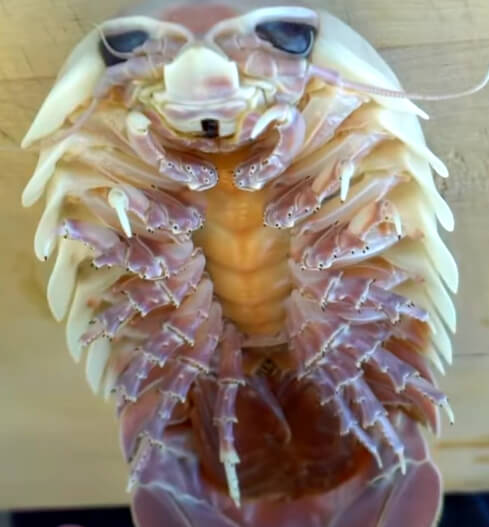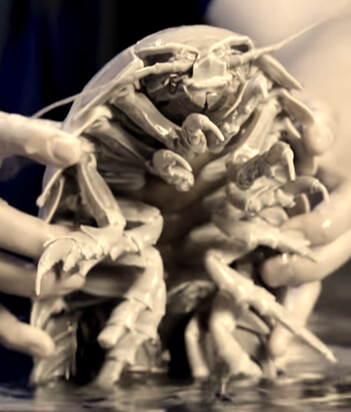What Giant Sea Cockroach Look Like?

The term “giant sea cockroach” may sound like something out of a sci-fi movie, but it refers to a marine creature known as Bathynomus. These are giant isopods, deep-sea relatives of the pill bugs, or woodlice that you might find in your garden.
Here’s a brief overview of the giant isopod:
- Appearance: Bathynomus species can indeed appear cockroach-like, with their segmented bodies, numerous legs, and large compound eyes. The largest of these, Bathynomus giganteus, can grow up to 40 cm (16 inches) in length, although there are also smaller species.
- Habitat: These creatures are found in the deep seas, typically between 170 meters (557 feet) to about 2,140 meters (7,020 feet) below sea level, though some can reside even deeper.
- Diet: Giant isopods are scavengers. They feed on the remains of dead animals that fall to the ocean floor, like whale carcasses. Their meals can be infrequent due to the sparse nature of food in the deep sea, so they tend to consume a lot at once when they find food.
- Life: The deep-sea environment is cold, high-pressure, and dark. Because of this, the metabolic rate of many deep-sea creatures, including the giant isopod, is relatively low. They can go long periods without food due to their slow metabolism.
- Significance: While they might appear intimidating or strange, giant isopods are a crucial part of the deep-sea ecosystem. As scavengers, they help recycle organic matter in the ocean depths. Studying them also provides insights into the adaptation mechanisms of marine life.

Why Should We Care?
The appearance of the Giant Sea Cockroach, with its armored segments and primeval design, can evoke reactions ranging from fascination to horror. Yet, beyond its looks, the Bathynomus holds significance in the intricate web of deep-sea ecology.
As scavengers, they play a pivotal role in recycling organic matter, ensuring that the deep-sea ecosystem remains balanced. Their presence aids in breaking down and recycling nutrients, supporting other marine life forms. The Giant Sea Cockroach, in its own right, is a keystone species crucial for maintaining the health of its habitat.
Moreover, studying these creatures provides invaluable insights into the adaptation strategies employed by life in the extreme conditions of the deep sea. By understanding their biology, we can gain broader knowledge about survival, resilience, and evolution in the world’s most inhospitable places.
Are giant cockroaches dangerous?
Giant cockroaches, such as the Madagascar hissing cockroach, are not dangerous to humans. They do not bite or sting and are often kept as pets or used in educational settings.
However, like all cockroaches, they can potentially carry and spread bacteria if they come into contact with contaminated surfaces. It’s important to maintain cleanliness if keeping them as pets.

Are giant isopods dangerous?
No, giant isopods are not dangerous to humans. They are deep-sea scavengers that feed primarily on decaying organic matter. They are not aggressive and do not have venom or any means of causing harm to humans.
Are shrimp the cockroaches of the sea?
This is more of a colloquial saying rather than a biological fact. Shrimp and cockroaches belong to the phylum Arthropoda but are quite distant relatives.
The saying likely comes from the superficial resemblance in their body structures and the fact that both are scavengers. However, shrimp are crustaceans and belong to a different subphylum (Crustacea) than cockroaches, which are insects (Hexapoda).
Giant Isopod Size
A giant isopod can reach up to 16 inches (40 cm) in length, making it significantly larger than its terrestrial relative, the pillbug, which typically measures less than an inch (2.5 cm). However, there are other smaller species of giant isopods as well.
Is the sea cockroach edible?
Technically, many arthropods, including isopods, are edible. In some cultures, smaller isopods (like the related woodlice) are eaten. However, giant isopods are not commonly consumed as food. Like all unfamiliar seafood, if they were to be eaten, they should be adequately prepared to ensure they are safe for consumption.
In Conclusion
The Giant Sea Cockroach is a testament to nature’s ability to thrive in even the most challenging environments. Its existence reminds us of the incredible biodiversity hidden within the oceans’ depths, waiting to be discovered and understood.
As we push the boundaries of exploration, diving deeper into the marine abyss, creatures like the Bathynomus serve as both guides and mysteries. They challenge our perceptions, spark our curiosity, and deepen our appreciation for our blue planet’s vast, intricate, and interconnected web of life.

James E. Butkovich, Pest control maven with a knack for eco-friendly & Chemical solutions. Blogger with a mission to make homes pest-free, one post at a time.